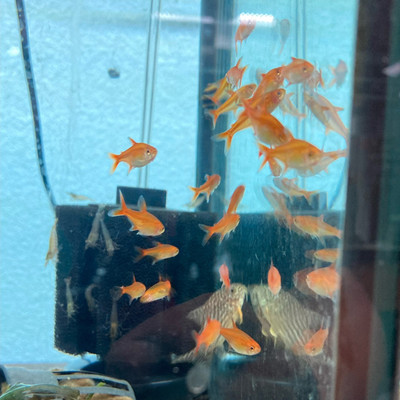Ember Tetras
Posted by Max Gandara on on 5th Mar 2025
Discovering the Ember Tetra: A Jewel of Freshwater Aquariums
The Ember Tetra (Hyphessobrycon amandae) is a small but captivating freshwater fish that has become a beloved choice for aquarists around the world. Known for their vibrant colors and peaceful nature, these little fish can transform any tank into a living masterpiece. In this blog, we'll dive into the fascinating world of Ember Tetras, exploring their origins, care requirements, and why they make such a delightful addition to your aquarium.
Origins and Natural Habitat
Ember Tetras are native to the slow-moving rivers and tributaries of the Central Brazil region, particularly the Araguaia River basin. They thrive in warm, slightly acidic waters, often surrounded by dense vegetation. This natural habitat provides them with ample hiding spots and a rich supply of food, which contributes to their excellent health and vivid coloration.
Appearance and Behavior
Ember Tetras are renowned for their striking orange-red hue, which makes them stand out in any aquarium setting. These small fish typically grow to about 0.8 inches (2 cm) in length, making them perfect for nano tanks or as part of a larger community aquarium. Their translucent bodies and iridescent scales catch the light beautifully, creating a shimmering effect that is simply mesmerizing.
In terms of behavior, Ember Tetras are peaceful and social creatures. They thrive in groups of six or more, as they are naturally schooling fish. When kept in larger groups, they exhibit more vibrant colors and playful interactions, creating a lively and harmonious environment in your tank.
Aquarium Setup and Care
Creating a suitable environment for Ember Tetras is essential to their health and happiness. Here are some key aspects to consider when setting up their aquarium:
-
Tank Size: While Ember Tetras are small, they still appreciate space to swim. A tank of at least 10 gallons is recommended for a small school.
-
Water Conditions: Maintain a temperature between 73°F and 81°F (23°C to 27°C) with a pH level of 6.0 to 7.0. Regular water changes and a good filtration system are crucial to keep the water clean and healthy.
-
Aquascaping: Mimic their natural habitat by providing plenty of plants and hiding spots using driftwood and rocks. This will help reduce stress and encourage natural behaviors.
-
Diet: Ember Tetras are omnivorous and should be fed a varied diet. High-quality flake food, supplemented with live or frozen foods like brine shrimp and daphnia, will help maintain their color and vitality.
Compatibility with Other Fish
Ember Tetras are excellent community fish due to their gentle nature. They coexist well with other peaceful species, such as other small tetras, rasboras, and dwarf corydoras. Avoid larger, aggressive fish that may view the tiny tetras as prey. A well-stocked community aquarium with a balanced mix of species will provide a dynamic and engaging environment for all inhabitants.
Breeding Ember Tetras
Breeding Ember Tetras can be a rewarding experience for aquarists looking to expand their skills. To encourage spawning, provide a separate breeding tank with plenty of plants for egg laying. Maintain optimal water conditions, and introduce a conditioned pair or group of Ember Tetras. After spawning, remove the adults to prevent them from eating the eggs. The fry will hatch within a few days and can be fed infusoria or specially formulated fry food until they are large enough to accept standard fare.
Conclusion
Ember Tetras are an excellent choice for both novice and experienced aquarists. Their stunning appearance, peaceful nature, and adaptability make them a joy to keep. By understanding their needs and providing the right environment, you can enjoy the vibrant beauty of Ember Tetras in your own home. Whether you're setting up your first aquarium or adding to an established community, these little fish are sure to bring a splash of color and life to your aquatic world.

